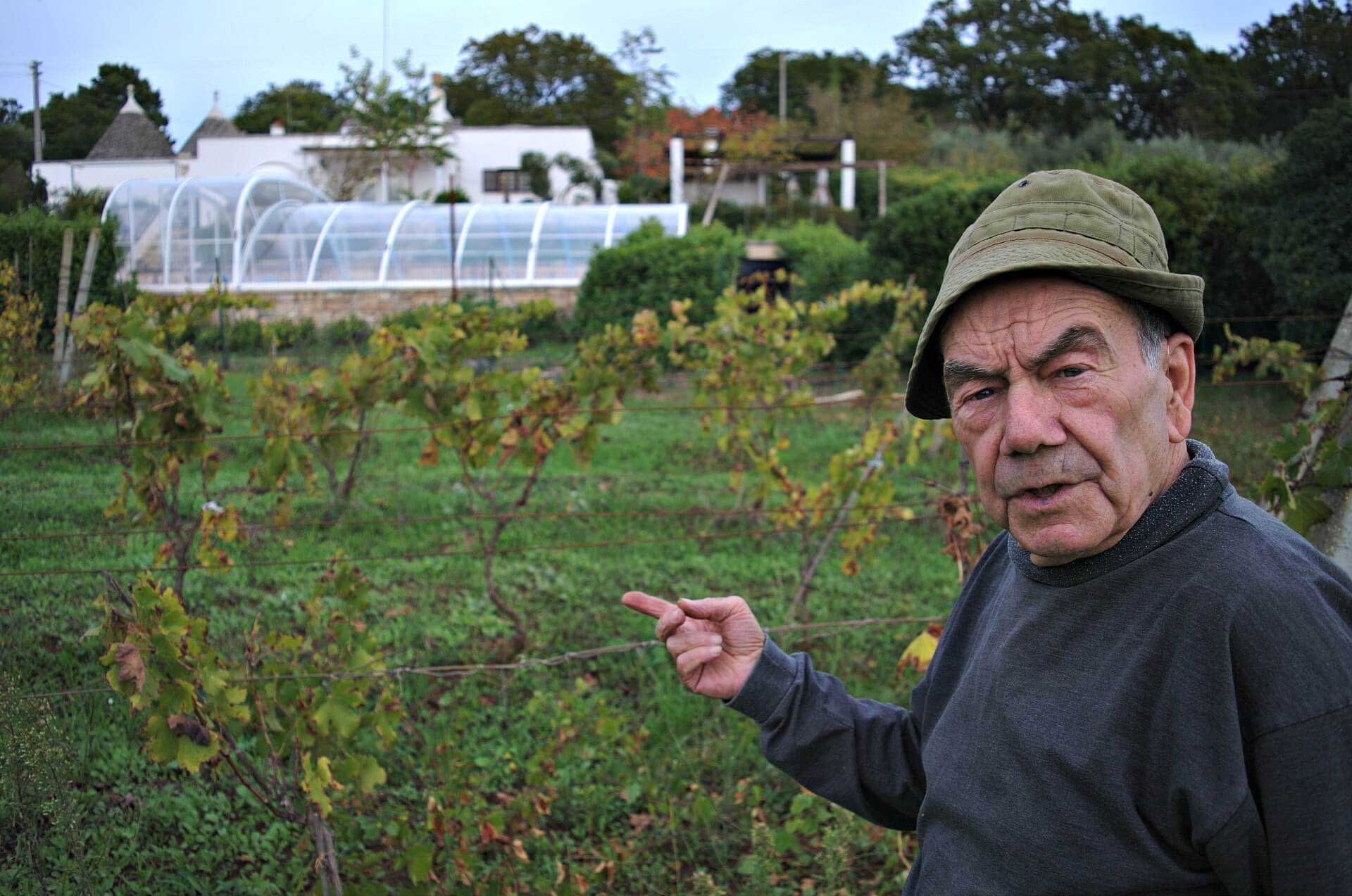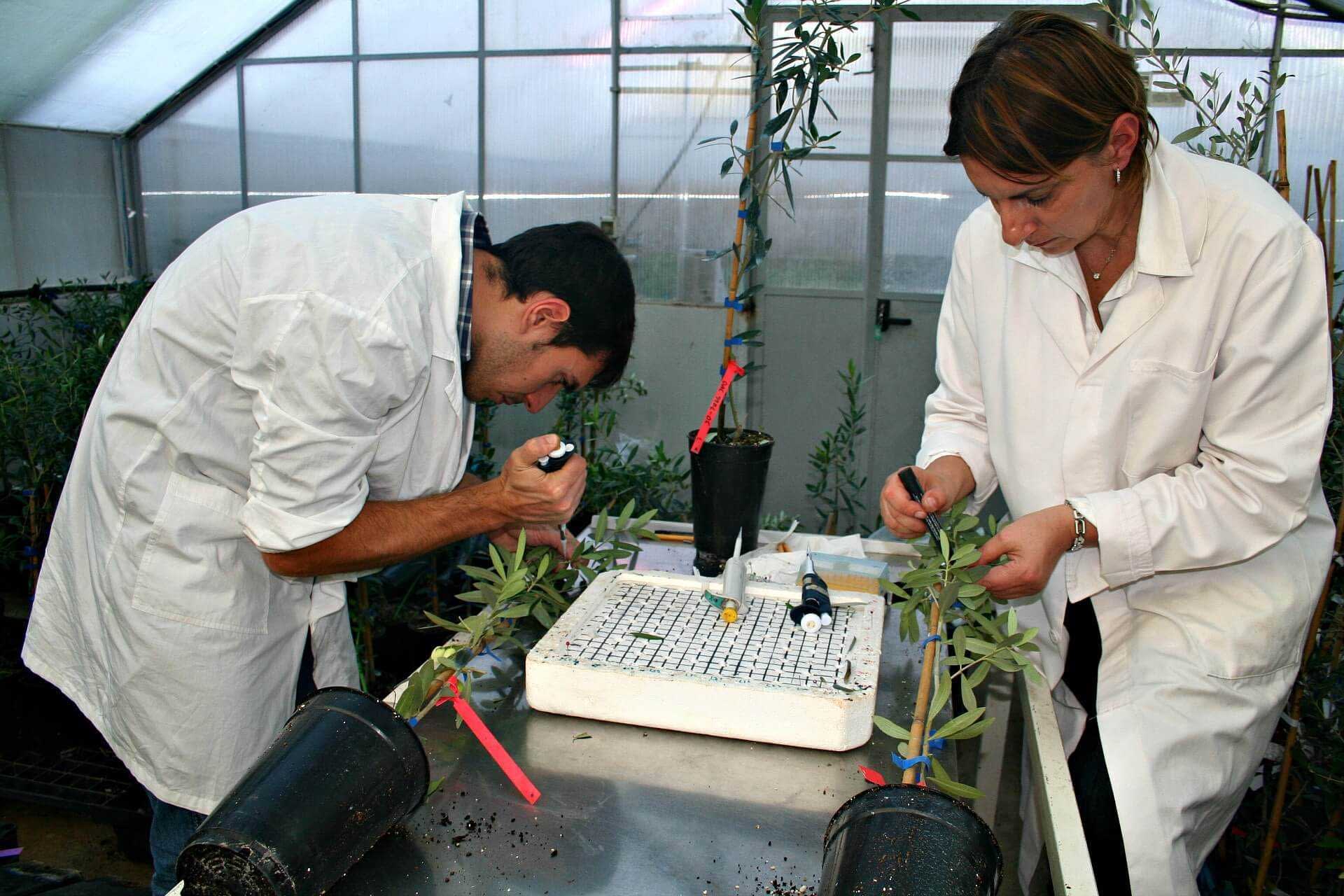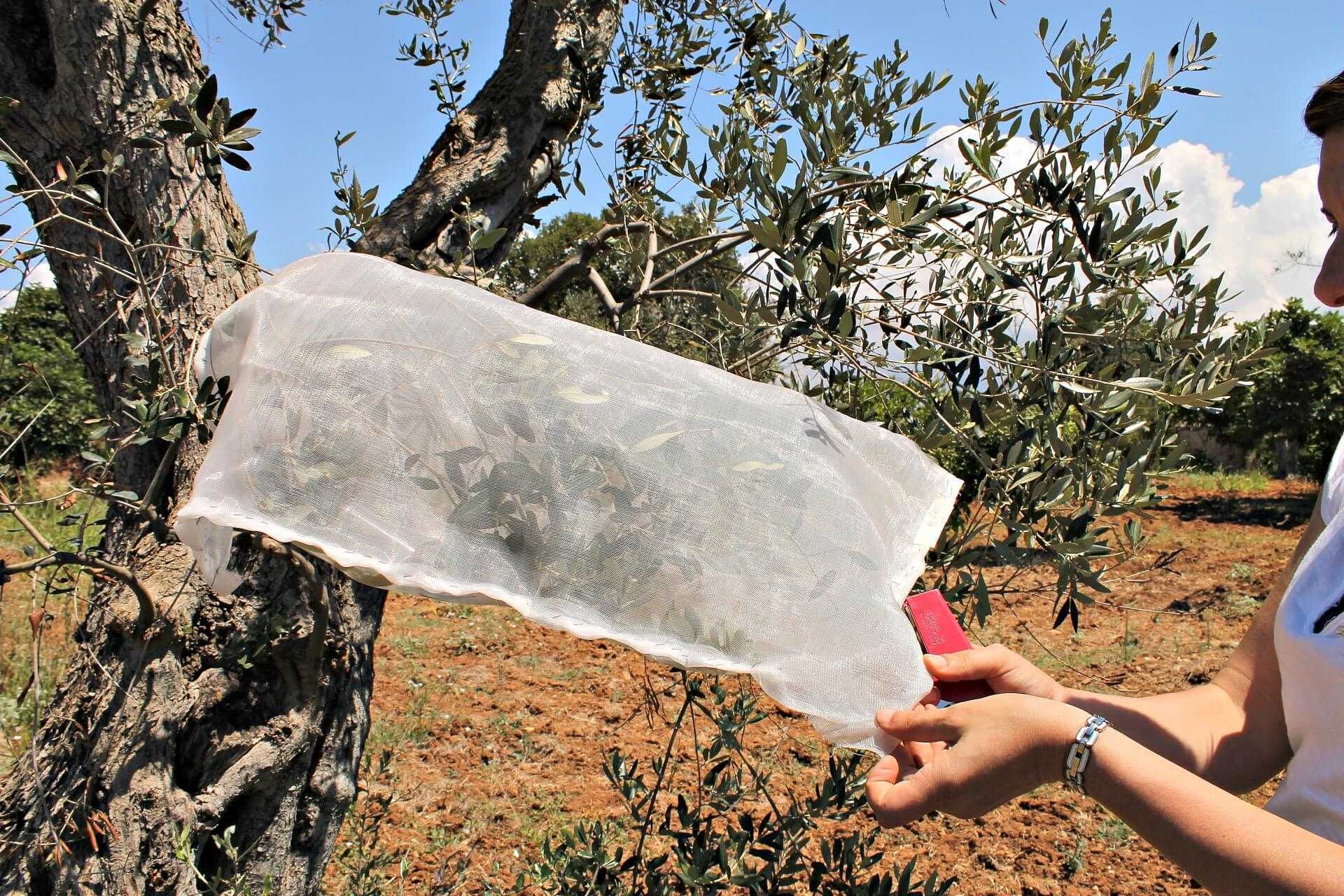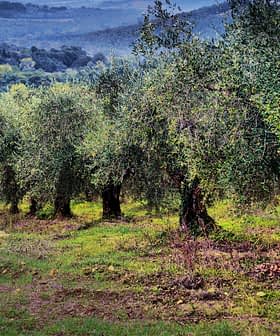Can Xylella Be Stopped?
Five years into the Xylella fastidiosa tragedy, scientists fear its continued spread may be inevitable.
 Gennaro Santoro (Photos: Cain Burdeau for Olive Oil Times)
Gennaro Santoro (Photos: Cain Burdeau for Olive Oil Times)The setting is a mellow fall day in the vineyards of the Santoro Tenuta in the Valle d’Itria, an agricultural wonderland now the epicenter of efforts to stop the spread of Xylella fastidiosa, a lethal plant bacterium killing thousands of olive trees here in Puglia, the boot-heel of Italy.
This is a stunning epidemic, and it must be difficult if not impossible to overcome the grief over the loss of cultural icons that have endured for centuries.
Gennaro Santoro, a 75-year-old vintner, was clipping away at grapes left dangling after the harvest. His vineyard is surrounded by olive orchards and he tends to olives around the tenuta’s winery.
I knew Gennaro from previous visits to the Valle d’Itria, and stopped in to hear his thoughts on Xylella, an ominous plant disease spreading in Europe from the New World that is the subject of an Olive Oil Times series.
Scientists compare what is happening today among olive orchards to what happened in the late 1800s in Europe with wine grapes. An aphid-like insect, the grape Phylloxera, was brought to England from the New World and wreaked death in Europe’s vineyards.
Gennaro Santoro’s own vineyard dates to that period when Phylloxera invaded France and spread to the rest of Europe. For several decades Puglia was untouched by Phylloxera and became wealthy supplying wine-starved Europe.

Gennaro Santoro (Photos: Cain Burdeau for Olive Oil Times)
“Yes, I will talk about that, about Xylella” Gennaro said amiably. “But let me show you first the autochthonous vines we’ve planted!” He’s a learned farmer of Swiss-Italian origins whose family goes back generations in this contrada, an Italian word for a small rural community or village.
With a background in biology and someone steeped in local history, his tour lasted an exhilarating hour.
He strolled the rows of vines, waved his pruning clippers in the air, and all the while recounted of feudal estates, the masserie founded by ex-Roman soldiers, and subsequent peasant revolts; and how eventually the braccianti, the peasants, came into possession of the valley.
Looking at the green hills running with rock walls, he offered ever more history.
“This was where Byzantine monks once stopped to give water to their herds, during the transhumance. You see, a foggia is a long ditch they dug to carry rainwater into the Murgia, where there’s no river, and no wells. There was a foggia here, and it was called Sauro.”
We got back to my vehicle in the small parking lot behind his family’s winery, where a few olive trees grow. The sun was setting and dinner time approached.
“But what about Xylella?” I asked him again.
He winced. “It’s all wrong. You can’t cut down all the olive trees. We must seek to live with the disease, as farmers have always done.”
He was optimistic, though, and certainly didn’t think the olive trees dotting his piece of countryside would fall victims to Xylella and die.
“We aren’t worried about our trees dying because we are organic,” he said confidently. “No one uses herbicides around us because it is outlawed.” Before bidding farewell, he added: “You can’t command nature. But you can adapt.”
His sentiments about Xylella go to the heart of a raging scientific and agronomic debate gripping Puglia, Italy’s most productive olive region.
The last five years have been riven with Xylella headlines, protests, political intrigue and a razed-earth strategy that has seen the clear-cutting of thousands of olive trees in Salento, a flat olive-rich area of southern Puglia.
“This is a stunning epidemic, and it must be difficult if not impossible to overcome the grief over the loss of cultural icons that have endured for centuries,” said Rodrigo Almeida, a Xylella expert at the University of California at Berkeley.
Now, five years into the tragedy, it’s becoming ever more ominous that the battle to eradicate Xylella may have been lost and scientists fear its spread may now be unstoppable and potentially even spread faster.

Scientists analyze olive samples for Xylella fastidiosa
Alexander Purcell, another Xylella expert at the UC-Berkeley, said that the disease is “so prevalent in most of Salento that eradication of Xylella is no longer considered possible.”
In December, Vytenis Andriukaitis, the European Commissioner-designate responsible for Health and Food Safety, warned that Xylella had become “the biggest phytosanitary crisis confronting the EU for many years.” He made his comments in Paris.
What to do then? Cut or not cut sick olive trees and their neighbors? It’s here that scientists are divided.
For now, the strategy remains to cut down and eradicate sick trees in areas where authorities are seeking to stem the disease’s spread, an area where Gennaro Santoro’s vineyard and olive trees are.
The disease appeared in the region about five years ago when farmers and scientists started investigating the sudden browning of olive leaves on trees near the port of Gallipoli in Salento.
The iconic olive tree is an evergreen – so any browning is cause for alarm.
Since Xylella fastidiosa was declared the culprit in 2013, the EU has demanded Italy undertake a radical eradication program to stop the spread.
Whether it’s lack of action by Italy or the sheer nature of the bacterium, eradication efforts have failed. And Xylella is on the march.
So far this year, hundreds of new trees are being cut down in areas not far from the Santoro vineyards.
The number of infected trees has quadrupled in one year in the critical containment zone, according to ANSA, the Italian news agency.
Another ominous development is taking place across the Mediterranean: Olive trees in mainland Spain are beginning to die due to Xylella, according to Spanish authorities and news reports. Spain is the world’s largest olive oil producer.
So far, though, Puglia is where death has been fiercest.
Tens of thousands of trees have been infected and thousands either cut down to prevent the spread of the disease or are dying due to infestation.
“The only way to fight it is the complete eradication of infected trees and their surroundings as so far no treatment exists for the bacteria,” Andriukaitis, the EU Commissioner, said in an email to Olive Oil Times.
He added that the disease could worsen due to climate change and globalization of trade.
“Since pests respect no borders everyone must play their part to keep plants healthy across the EU and to avoid serious consequences for our agriculture, our economy and our local communities,” he said.
In Puglia’s areas where the bacterium has already wreaked havoc and where scientists say it can no longer be eradicated, farmers are left having to cope with the bacterium.
“Co-existence with this sickness is a goal the whole sector wants to get to,” said Marco Scortichini, a plant bacteriologist at the Council for Agricultural Research and the Analysis of Agricultural Economics, an Italian research arm that specializes in olive cultivation.
“Reduction of bacterium incidence will not be impossible,” he said in a telephone interview. “Co-existence is something that can be achieved.”
“I don’t doubt it’s Xylella (killing trees),” said Christos Xiloyannis, a plant physiologist at the University of Basilicata, in a telephone interview. “It’s a question about how to intervene.”
Funds have poured into understanding and combating the disease and scientific studies have been published looking at Xylella from nearly every angle: How does it spread? How does it strangle plant tissues? What varieties are resistant? How best to spray against the bacterium? How to graft infected trees? How to monitor the infestation?
Science has answers to a lot of these pressing questions and important breakthroughs have been made. Perhaps the most important discovery has been that some varieties of olives are naturally resistant to Xylella — a fact giving hope to many farmers who are now replanting with a resistant Leccino variety.
But there are other projects underway too. For example, some farmers are seeking to replenish their orchards by grafting Xylella-resistant stocks onto old trunks.
Measures to combat the vector, a common spittlebug, have been implemented too. Landowners now face hefty fines for not tilling or cutting the grass in their fields to kill the spittlebugs that grow in weeds.

An experiment to artificially infect a tree with Xf, part of efforts to find resistant olive varieties
Among the promising fieldwork is one Scortichini is working on in Salento. His latest study, which appeared in April in the science journal Phytopathologia Mediterranea, showed that a copper-based spray was showing positive results in combating the bacterium. Other scientists have questioned the study’s findings as far from conclusive.
“When it comes to trees, forests, you can’t cut them all down,” Scortichini said.
This is a common statement among agronomists, scientists and farmers. They say olive trees are unlike other infected crops – whether animal or plant.
Why? Because they are unique evergreen fruit trees that can survive centuries. In this sense, this olive sickness is at a different scale than Mad Cow Disease in Great Britain and even the Phylloxera outbreak. Under this view, cutting down trees is not the solution and it’s not viable.
“Our advice is to return to the countryside and spend time cultivating,” Xiloyannis said. “We’ve never been able to eradicate diseases that have appeared in the last 30 – 40 years.”
He said it was very likely that Xylella broke out in Salento because olive orchards had become abandoned and poorly managed, making them susceptible to pathogens.
In part, the European Union is to blame for this, he said, because it was encouraging farmers to cultivate in this manner.
Xiloyannis said he is working with farmers to improve their land practices to fend off the disease – an echo of what Gennaro Santoro, the vintner, said about his confidence in his trees. As of April, the trees on the Santoro vineyard had not been infected, his son, Marco Emilio Santoro, told Olive Oil Times.
Xiloyannis said cutting and replanting new olives is simply not feasible in many areas of Puglia and there is no guarantee that cutting old trees and replacing them with a resistant-variety will work in tough terrains.
Still, planting the Leccino and possibly other bacterium-resistant varieties, for now, appears to be the only way of combating Xylella, some scientists say.
“At present, the only possible thing which seems to work, albeit data are still preliminary, seems to be planting resistant olive varieties,” said Enrico Bucci, a systems biology researcher at Temple University, in an email.
This is the focus of Donato Boscia, a leading researcher into the Xylella outbreak at the Institute for Sustainable Plant Protection in Bari.
“There is no cure for Xylella at this point,” he said in a telephone interview.
For now, he is working in Salento to find olive cultivars resistant to the bacterium. He said research has shown the Leccino and Favolosa varieties are resistant and he is optimistic many more may be too.
The prospect of this remedy eerily hearkens back to Phylloxera.
Both pests are native to the Americas. Both cause leaves to brown and die, strangling and killing its host plant, and both move on to find the next victim.
In the end, Europe learned to live with Phylloxera, but only after nearly every vineyard was replanted with wild American rootstocks that are resistant to the root-destroying bugs.








